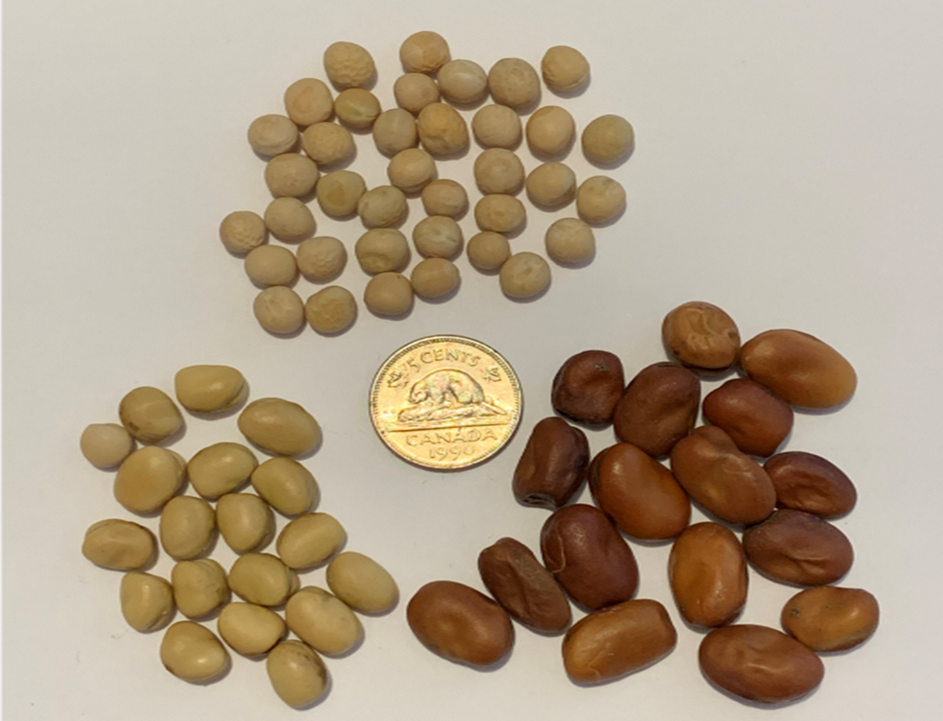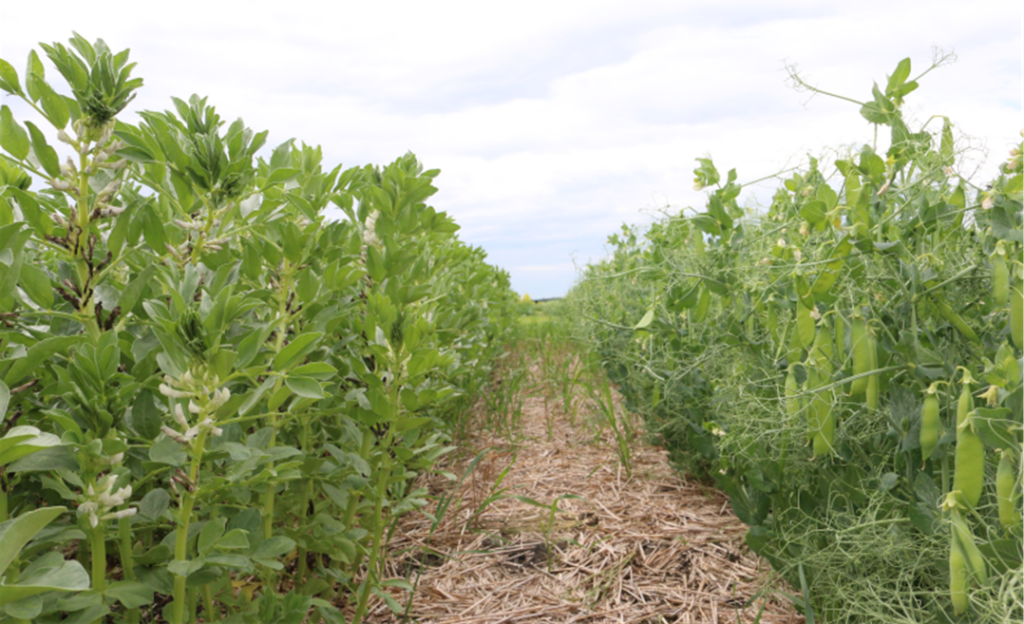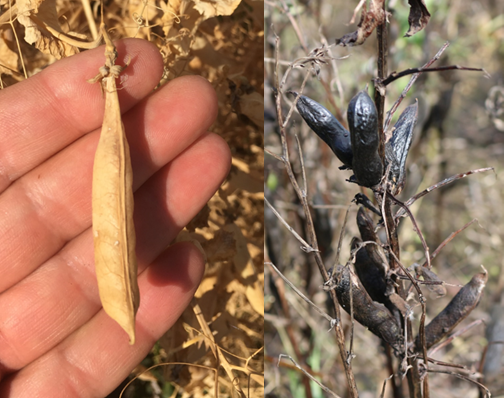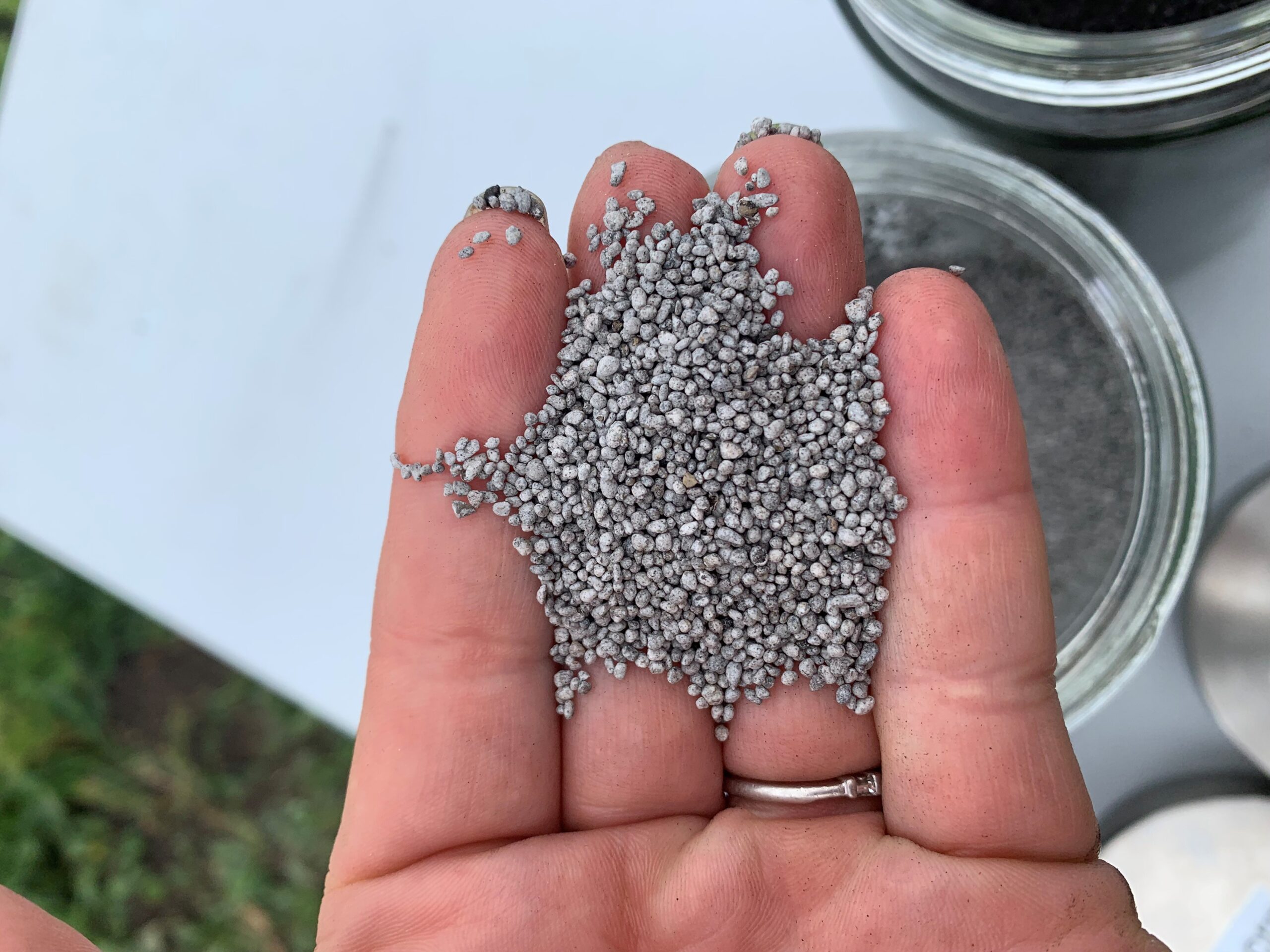by Vicki Dutton and Sherrilyn Phelps, PAg.
Are you deciding whether to grow peas or faba beans on your farm this year? While both are pulses, their similarities end there. Producing nitrogen from the air is what they have in common, but these two crops have very different operational challenges and opportunities on your farm.
If Aphanomyces root rot has been a factor in lowering your pea yields, and you have good moisture as a rule, then faba beans are a great pulse crop option. Faba bean is resistant to Aphanomyces, and its tap type root responds well to extra moisture which can tolerate saturated conditions more so than peas. Its high water tolerance and requirement make faba beans an ideal candidate for irrigation but use caution as it does not like saline soils.
Seeding
Faba beans must be seeded early, the earlier the better, as they will germinate at soil temperatures of 3-5°C (compared to 5°C for peas). Faba beans will take longer to break ground than peas, so it is often at least two weeks (sometimes more in heavy soils) before you will see emergence, which is normal. While data support early seeding for both crops, with faba bean early seeding is essential.
Peas offer much more flexibility at seeding time. The much shorter maturity of peas (about 90 days) offers a wider range for seeding dates. Highest yields and best quality are obtained with early seeding of peas, but they can be seeded into early June. Seeding early avoids the traditional July heat and optimizes peas for an early harvest. Faba beans have a much longer maturity window of 104-110 days from seeding to physiological maturing (swathing stage), so they must be seeded early. Some recommendations use May 7 as the best seeding date.
Where to seed faba beans is also an important consideration compared with peas. Faba beans cross pollinate and therefore seeding different varieties in close proximity should be avoided.
Seeding faba beans can be more challenging than peas due to the larger seed size, and the difficulty moving the size and volume of seed through seeding equipment.
Faba bean seed sizes range greatly compared to peas (Table 1). With faba beans the target plant population is 45 plants per square metre (m2) or four plants per square foot (ft2). Peas have a target density of almost twice that of faba beans at 85 plants/m2 (8 plants/ft2). Typically seeding rates for peas range from 180-240 pounds per acre (lb/ac) or 3-4 bushels per acre (bu/ac), whereas faba beans seeding rates can vary tremendously based on the variety chosen and the seed size of the particular lot. Smaller seeded faba beans can be seeded at rates similar to peas (3.5-4 bu/ac). However, larger seeded faba beans may need rates above 360 lb/ac (6 bu/ac) which can be difficult with most seeding equipment.
Pea vs. Faba Bean Differences
| Peas | Faba Beans | |
|---|---|---|
| Seed Size | 160-270 grams | 325-700 grams |
| Target Plant Population | 85 plants/m2 (8 plants/ft2) | 45 plants/m2 (4 plants/ft2) |
| Minimum Soil Temperature | 5oC | 3-5oC |
| Seeding Depth | 3-8 centimetres (1.5-3.5 inches) | 5-7.5 centimetres (2-3 inches) |
Rolling
Faba beans stand well, so land rolling them is optional. They typically pod well above the soil surface, but there are conditions which cause regrowth from the seed (cutworm damage, severe spring frost, etc.) that can lead to podding closer to the ground. With peas land rolling is a must as the crop is susceptible to lodging and often needs to be cut right at the soil surface or picked up off the ground.


Fertility
Faba beans can have a positive effect next years crop. Most producers are amazed at the crop grown the year after faba beans, and some even see benefits two years after.
This can be attributed to the soil benefits of a pulse in rotation as well as the nutrient contributions. Faba beans are the top pulses in terms of the total amount of nitrogen fixed and the percentage of nitrogen derived from fixation. Estimates on the amount of nitrogen (N) fixed for faba beans and peas are 80-200 lb nitrogen and 50-150 lb/ac, respectively. Even though faba beans can fix more nitrogen, they also remove more in the grain due to higher yields and higher protein content. In reality, the nitrogen benefit for both crops is similar at 0.5-1 lb N/bu of grain removed and both provide benefits to following crops in rotation.
Removal rates for phosphorus (P) have just been updated for faba beans in Saskatchewan and are the same as for peas at 0.7lb of P/bu of grain removed. As faba beans typically have higher yields higher rates of phosphorus should be considered. Both crops are equally good scavengers of phosphorus. When considering rates of fertilizer it is important to know that peas are much more sensitive to seed placement. Peas can only tolerate 15 lb of P seed-placed while faba beans can tolerate upwards of 40 lb/ac before emergence is affected.
Weed Management
Both crops are not that competitive during early stages of vegetative growth. The critical weed free period for both is early. With faba beans seeded into cold soils, the spring burn off can be delayed until after planting, but should be done well in front of emergence to ensure the crop has a head start on weeds. The weed control options for faba beans is similar to peas, but there are a few less products to choose from.
Disease Management
Chocolate spot (Botrytis sp) is the biggest concern with faba beans, however there are other diseases such as Alternaria and Stemphylium blight that have also been found more recently. Sclerotinia is not usually a concern in faba beans. It is difficult to tell faba bean foliar diseases apart and there is limited information on the effect on yield and quality, which makes fungicide decisions difficult. The diseases of concern can appear later in the season with faba beans which may mean less impact on yield. Scouting fields in July is important for monitoring disease pressure in faba beans. With faba beans only one fungicide application is recommended unless under very heavy disease pressure.
Avoid fungicide applications late in the season as it can keep the fields greener and extend maturity.
With peas, fungicide application is a common practice as the yield and quality factors are well documented. Controlling Aschochyta/Mycospharella blight, which is the main disease of concern, has proven benefits when applied in early flower. Second fungicide applications may be warranted with high risk environments.
With faba beans, summer storms should find you scouting the field daily as the big-leafed plant is rather fragile despite its robust look. Chocolate spot or other foliar diseases can significantly impact yield if infection occurs early as they spread rapidly under the right conditions.
As with peas, seed treatments are often recommended with faba beans due to seeding into cold moist soils and due to the longer time for emergence. Higher tannin types of both peas and faba beans have greater resistance to seed borne diseases such as Fusarium, Pythium and Rhizoctonia, due to the tannins in their seed coats.
Insect Pressures
As for both crops, peas and faba beans are susceptible to insect pests such as pea aphids and pea leaf weevils, but the thresholds for faba beans are still yet to be determined. Lygus bugs from canola and alfalfa can be an issue with faba bean and can dramatically affect quality, resulting in black marks on the seed, that can cause reduced grade.
Harvest Management
Fall is the biggest difference between faba beans and peas. Peas have a much shorter maturity (90 days) and will be ready for a combine in August or early September, well before the risk of frost. The 106-110 day faba beans will linger on into September, even October.
On our farm we harvest peas first and faba beans last. Both crops can be used to extend harvest timing, which can help with managing harvest with other crops. Once the faba bean plant is ready for combining, harvesting is simple as it sheds itself down to pods and a stock. Even on a cool, moist day if the seed has dried down, you can harvest faba beans.


Desiccation
Desiccation or harvest management with peas is straight-forward as the days are longer and usually the warmer temperatures speed drydown.
With faba beans it is more difficult to have success with harvest aids in the fall, due to cooler temperatures and large biomass. In some cases, the onset of disease or dry conditions can speed up the maturity of faba beans.
Faba beans stand well and do not shatter which means they will withstand more adverse conditions compared to peas. Faba beans have been successfully combined with some snow on the ground and even in the spring, which is not an option with peas. We know with peas when it comes to harvest, standability can be a challenge. Quality is riskier with faba beans. Longer maturity means higher risk of frost damage, and weathering. Peas typically come off in good quality, with the exception of the risk of bleaching in green peas. Peas do have thinner seed coats and are more susceptible to seed coat breakage during handling. The thicker seed coat of a faba been reduces damage, but indeed they still need to be handled gently to reduce damage.
Markets
With 4 million tonnes of peas and decades of market development, we have buyers from all around the world (big to small, vessel to container, feed to food, bulk and niche markets). In other words the pea market dwarfs the 100,000 tonne Canadian faba bean market. Faba bean is both a niche and an emerging market, and like all developing markets, accessing future demand is one of the more important cropping decisions as well as managing cash flow needs.
Egypt is a major buyer of both tannin and zero tannin varieties, and while minor uses exist elsewhere, Egypt is the primary buyer. Global competition from other production zones closer to the market is high for faba beans. The demand and value of Canadian faba beans is dependent upon the quality and quantity of traditional origins which is predominantly tannin beans.
As a result, the window of timing for Canadian sales in Egypt is highly dependant on global situation. Canada’s zero tannin production is a relatively new item on the menu in Egypt, as small quantities of food-grade, nice quality faba beans are being imported (estimated at under 20,000 tonnes). Tannin beans, like FB9-4, compete favourably with the Australian faba beans and have managed premiums in the last two years, due to Australian production issues. The new Fabelle variety should compete with mainline European Union production.
Market access for faba beans in the future may include pet food, aquaculture, livestock and poultry feed, and plant-based protein foods (splits and flour). Defining these markets is a work in progress but the advantage of faba bean is that it is a higher protein (26-32%) compared to pea (19-25%).
Driven by cropping alternative interest from producers we expect Canadian faba bean supplies to increase and drive increased consumption by domestic feed compounders as they incorporate this high protein, palatable crop into their rations. We expect this trend to become global as well as faba beans are an excellent feed source. In the future, the food market is expected to gravitate to the new low vicine/convicine varieties and Canada expects to find a branded edge with food-grade demand for ingredients.


Summary
Faba bean is well suited to the higher moisture areas in the province such as the Black soil zone north of highway 16, or under irrigation. The best way of incorporating this crop is by rotating peas and faba bean on a four-year cycle to provide the needed break for managing Aphanomyces root rot. The diversity of the rotation, the nitrogen benefit, and increased flexibility in the timing of harvest management are notable advantages of having both pea and faba bean as part of a long term rotation.
Pea vs. Faba Bean Comparison
| Peas | Faba Beans |
|---|---|
| Easy to seed | Challenging to seed |
| Do not like wet feet or excess water | Like water especially in July/August |
| Susceptible to Aphanomyces root rot | Resistant to Aphanomyces root rot |
| Early maturity (90 days) | Late maturity (104+ days) |
| Lodging issues | Stand well |
| Challenging to harvest | Combine easily |
| Market acceptance globally | Markets under development |



